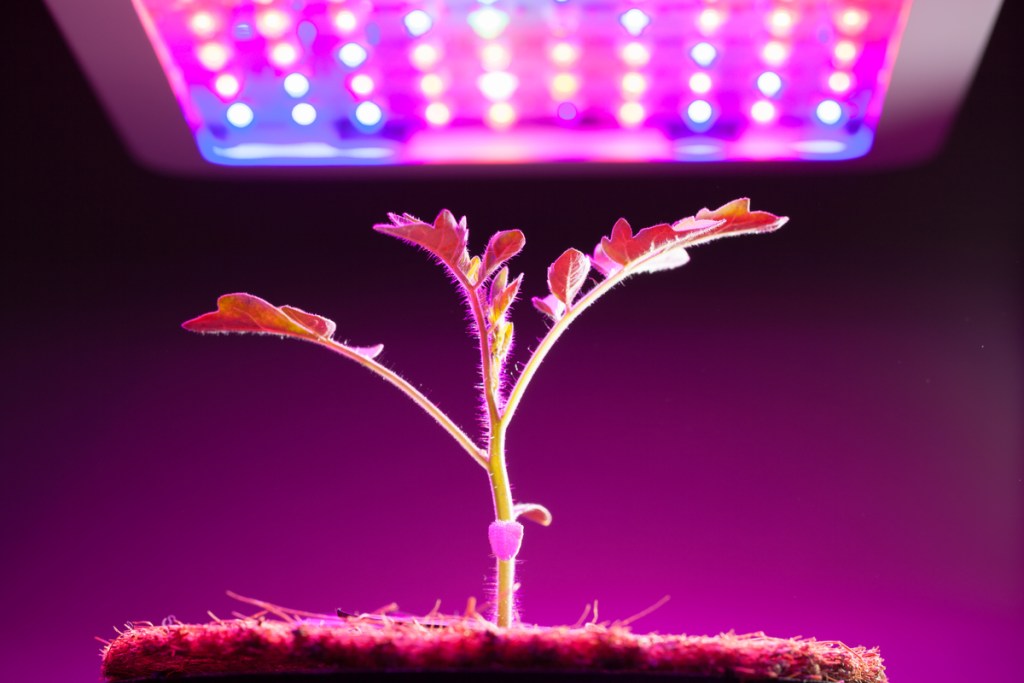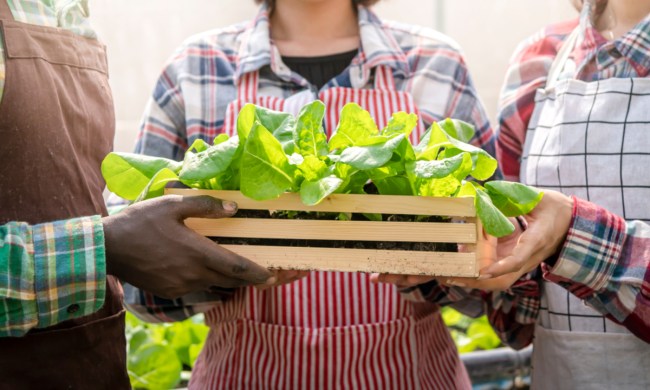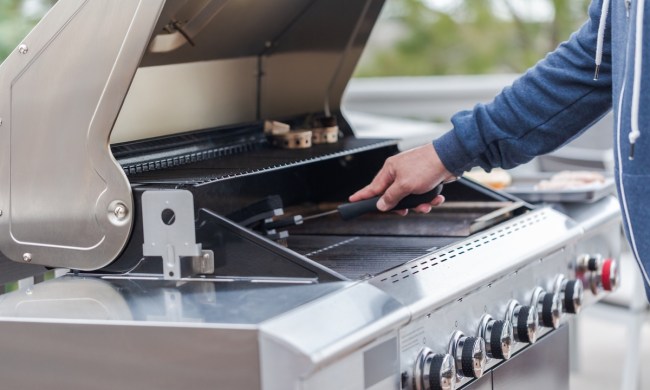Just like growing houseplants indoors, growing plants in a greenhouse requires specific care and a suitable environment. Even though the greenhouse will have some light from the sun coming in, the glass panes are often filtered in some kind of way to prevent your plant’s leaves from scorching. Enter grow lights. They’re used most commonly in darker spaces or during colder months; however, they’re greatly beneficial to your greenhouse plants and help ensure that the plants are getting the light they need to thrive.

Can you have an indoor greenhouse?
Absolutely! Indoor greenhouses are revered for how sustainable and inexpensive they can be. An indoor greenhouse with lights can be installed anywhere in the home where you have the space, and it’s a perfect place to grow things like fruits, herbs, and veggies indoors. If you’re only planning to grow a couple herbs, you can get something as small as a tabletop greenhouse! It will fit a few plants, won’t take up too much space, and will add to the aesthetic of a room while letting you grow plants in a unique way.
Similar to other houseplants, the indoor greenhouse will still need to be placed in a spot where there’s adequate lighting (unless you intend to buy grow lights, which is arguably why you’re here!) and consistent temperature. Keep it away from drafty windows or doors where possible.
What’s the cost of installation?
The cost of your indoor greenhouse will depend largely on the size. They’re relatively inexpensive options when compared to outdoor greenhouse setups. What you spend also depends on whether or not you need additional items, such as grow lights, humidifiers, and space heaters. Everyone’s budget is different, so if you’re limited on cost, it’s best to opt for a smaller one (which can be as little as $30) and invest in grow lights before looking for more extra bits and bobs.
What kind of light should you use for an indoor greenhouse?
Different light spectrums bring different benefits, so it’s important to consider what outcome you’re looking for when choosing grow lights for your greenhouse. For example, plants have been shown to absorb the most chlorophyll when exposed to red and blue lights as opposed to white lights. If you’re considering cutting back on costs, incandescent lights are a cheap alternative; however, keep in mind that they’ll need to be placed further away from the plants due to the amount of heat they produce. Like sun rays coming directly through a window, the heat from incandescent lights can scorch the leaves.
Choosing the right light spectrum
When we talk about the light spectrum for grow lights, we’re looking specifically at wavelengths that are ideal for plants and the benefits they bring to the table. The lighting you choose for your greenhouse will be mostly supplementary, as your plants will still be receiving some sun. The part of the spectrum lights usually use for photosynthesis is between 400 and 700 nm and includes blue, green, and red light. Photomorphogenesis (the development of the structure of a plant) happens more broadly between 260 and 780 nm, adding in UV and far-red light.
But how do you know which light is best to use? It boils down to what each light can do for the plant.
- UV light (100 to 400 nm). UV light can be harmful to plants and isn’t the best option to use in a greenhouse, especially since there isn’t enough concrete information on how poorly it can affect plants; however, you may see this option available because it’s thought to increase resistance to environmental stress, fungi, and pests.
- Blue light (400 to 500 nm). Blue light is mainly used for its positive effects on flowering and growth. When combined with other light times, it helps with root development and with increased chlorophyll absorption.
- Green light (500 to 600 nm). Green light often isn’t used, either, because it isn’t as readily absorbed by the plant; however, it can potentially help with photosynthesis in lower leaves when used in combination with other light types. Green light should never be used on its own, if at all.
- Red light (600 to 700 nm). Red light is the other most common spectrum used in grow lights. It helps stimulate photosynthesis and increase plant growth, and you’ll most often see red and blue light spectrums together. Growing plants under red lights only (without the blue light’s bushy effect) results in lanky, stretched-out plants.
- Far-red light (700 to 850 nm). Far-red light is said to help promote flowering and expand leaves, which can increase the surface area a plant uses for photosynthesis; however, like red light, far-red should never be used on its own.
The most common light spectrums you’ll see (and likely the ones you’ll use in your greenhouse to supplement natural sunlight) are red and blue lights.
The different bulbs you can pick from
There are four different kinds of grow light bulbs you can choose for your greenhouse. The one you pick will depend on the specific needs of your space and your plants. Let’s break them down.
- High-intensity discharge (HID) lights. These lights will have to be installed a bit away from the plants due to the amount of heat they produce. They are, however, efficient in larger greenhouses where there are many plants across a wide area.
- High-pressure sodium lights. This type of light is a red light, which is primarily used to encourage budding and flowering. If you’re growing fruits, veggies, or flowers in your greenhouse, this type is a great option.
- Light-emitting diode (LED) lights. LED lights are one of the newest, yet perhaps the best, lights in regards to energy efficiency and lifespan. They typically offer both the red and blue light spectrums and are lightweight and easy to install.
- T-5 lights. These are full-spectrum fluorescent lights that are known for using less power than conventional options. Fluorescent bulbs usually emit blue lighting, which helps encourage fuller growth from plants.
Grow lights are especially important during the winter months if you’re looking to garden in your greenhouse year-round. Keep your budget in mind and the kind of lighting you need, and you’ll be able to easily choose what grow light is the best for you.

A couple grow lights to get you started
Because of all the nuances with light spectrums and bulb types, it can be a bit overwhelming to know where to start. Here are a couple grow lights to get the gears going — but don’t be afraid to search for something else! These recommendations may work for your light needs and your budget, or you may find yourself looking for something else entirely.
Roleadro LED grow lights
Roleadro’s LED grow lights are a great starting point for outdoor greenhouses and larger indoor greenhouses. They’re full spectrum, with both red and blue lights, and were designed with heat dissipation in mind. These grow lights are lightweight and easy to set up, and you won’t have to worry about the hanging brackets giving out.
Price: $32
Mindful Design LED indoor garden
This little indoor garden setup comes complete with built-in LED grow lights for your plants! If you aren’t sure where to start, getting the whole thing in one go is a great option. This keeps your indoor greenhouse on a small scale and at an affordable price point while limiting your search for the best grow light.
Price: $40
Every indoor and greenhouse gardener grows different plants and has different needs. There isn’t really a “best one” for any scenario because of how much it depends on the size of your space and the number of plants. With research, you’ll be able to find the grow light that works for you and keeps your plants happy.


